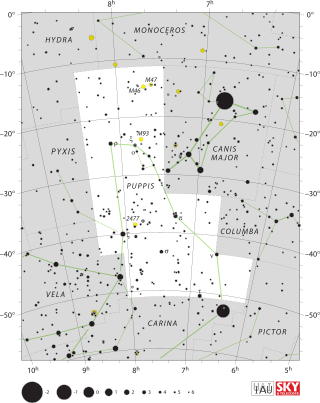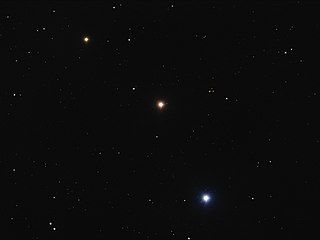Related Research Articles

Alpha Phoenicis, formally named Ankaa, with the same pronunciation) is the brightest star in the constellation of Phoenix.

Tau Sagittarii is a star in the southern zodiac constellation of Sagittarius.
65 Andromedae, abbreviated 65 And, is a single, orange-hued star in the northern constellation of Andromeda. With an apparent magnitude of 4.73, it is visible to the naked eye. The distance to 65 And can be derived from its annual parallax shift of 7.5 mas, which yields a range of around 440 light years. At that distance, its brightness is relatively lowered primarily by the inverse square law but also by an extinction of 0.16 magnitude due to interstellar dust. The star is moving closer to the Earth with a heliocentric radial velocity of −5 km/s.

6 Boötis is a binary star system in the northern constellation of Boötes, located around 460 light years away from the Sun. It has the Bayer designation e Boötis; 6 Boötis is the Flamsteed designation. The system is visible to the naked eye as a faint, orange-hued star with an apparent visual magnitude of 4.92. It is moving closer to the Earth with a heliocentric radial velocity of −3 km/s.
Phi1 Cancri, Latinised from φ1 Cancri, is a solitary, orange-hued star in the constellation Cancer. It is faintly visible to the naked eye with an apparent visual magnitude of +5.57. Based upon an annual parallax shift of 8.74 mas, it is approximately 370 light-years from the Sun.
6 Canis Minoris is a star in the equatorial constellation of Canis Minor, located around 570 light years away from the Sun. It is visible to the naked eye as a faint, orange-hued star with an apparent visual magnitude of +4.55. This object is moving closer to the Earth with a heliocentric radial velocity of −16.3 km/s. Kinematically, it is a member of an outlying group belonging to the Ursa Major flow of the Sirius supercluster.

Theta Cassiopeiae or θ Cassiopeiae is a solitary star in the northern constellation of Cassiopeia. It shares the traditional name Marfak with μ Cassiopeiae, positioned less than half a degree to the WSW, which is derived from the Arabic term Al Marfik or Al Mirfaq (المرفق), meaning "the elbow". At an apparent visual magnitude of 4.3, Theta Cassiopeiae is visible to the naked eye. Based upon an annual parallax shift of 24.42 mas, it is located about 134 light years from the Sun. It has a total annual proper motion of 0.227 arcseconds per year, and is slowly drifting further away from the Sun with a radial velocity of 2.5 km/s.

Tau Puppis, Latinized from τ Puppis, is a star in the southern constellation of Puppis, near the southern constellation boundary with Carina. It is visible to the naked with an apparent visual magnitude of +2.95 and is located at a distance of about 182 light-years from Earth. The variable radial velocity of this system was detected by H. D. Curtis and H. K. Palmer in 1908, based on observations made at the D. O. Mills Observatory. It is a spectroscopic binary star system, with the presence of the secondary component being revealed by the shifts of absorption lines in the spectrum resulting from the Doppler effect. The two components orbit each other with a period of 1,066.0 days and a low eccentricity of 0.090.
HD 197036 is a single star in the northern constellation Cygnus. It has an absolute magnitude of −1.15 and an apparent magnitude of 6.61, below the max naked eye visibility. Located 1,310 light years away, it is approaching Earth with a heliocentric radial velocity of −15 km/s.

R Boötis is a variable star in the northern constellation of Boötes. Typically the star is too faint to be readily visible to the naked eye, with a brightness that fluctuates between apparent visual magnitudes of 9.98. The distance to this star is approximately 2,150 light years based on parallax measurements. It is drifting closer with a radial velocity of about −58 km/s.
24 Vulpeculae is a single, yellow-hued star in the northern constellation of Vulpecula. It is faintly visible to the naked eye with an apparent visual magnitude of 5.30. The distance to this star can be estimated from its annual parallax shift of 7.9700±0.0674, which yields a separation of roughly 409 light years. It is moving further away with a heliocentric radial velocity of +15 km/s.

6 Draconis is a single-lined spectroscopic binary star system in the northern constellation of Draco, located about 430 light years away from the Sun. It is visible to the naked eye as an orange-hued star with an apparent visual magnitude of 4.95. The system is moving further from the Earth with a heliocentric radial velocity of 3 km/s.
Omega Eridani is a binary star system in the constellation Eridanus. It is visible to the naked eye with an apparent visual magnitude is 4.37. The distance to this star, as determined by the parallax method, is around 235 light years.
Upsilon1 Eridani is a single star in the constellation Eridanus. It has an apparent visual magnitude is 4.51, which is bright enough to be faintly visible to the naked eye on a clear, dark night. The distance to this star, as determined using the parallax method, is around 127 light years.
111 Herculis is a suspected astrometric binary star system located 92 light years from the Sun in the northern constellation Hercules. It is visible to the naked eye as a faint, white-hued point of light with an apparent visual magnitude of 4.34. The system is moving nearer to the Earth with a heliocentric radial velocity of −45 km/s, and may come as close as 37 light-years in 537,000 years.
HD 81799 is a suspected astrometric binary star system in the equatorial constellation of Hydra. It is visible to the naked eye with an apparent visual magnitude of 4.69. The distance to this system, as determined from an annual parallax shift of 19.9 mas, is 164 light years. It is moving further away from the Earth with a heliocentric radial velocity of 29 km/s. The system has a relatively high rate of proper motion, traversing the celestial sphere at the rate of 233±19 mas/yr along a position angle of 136°.

GZ Velorum is a single, orange-hued star in the southern constellation of Vela. It is a faint star but visible to the naked eye, having an apparent visual magnitude of 4.58. The star is located around 1,300 light years from Earth, as determined from its annual parallax shift of 2.4 mas. It is moving further away with a heliocentric radial velocity of +13 km/s.

Nu2 Coronae Borealis is a solitary, orange-hued star located in the northern constellation of Corona Borealis. It is faintly visible to the naked eye, having an apparent visual magnitude of +5.4. Based upon an annual parallax shift of 5.49 mas, it is located roughly 590 light years from the Sun. At that distance, the visual magnitude is diminished by an extinction of 0.1 due to interstellar dust.

3 Piscis Austrini, also known as HD 201901 or simply 3 PsA, is an astrometric binary located in the southern constellation Microscopium. It was once part of Piscis Austrinus, the southern fish. The system has a combined apparent magnitude of 5.39, making it faintly visible to the naked eye under ideal conditions. Gaia DR3 parallax measurements imply a distance of 404 light years and it is currently approaching the Solar System with a heliocentric radial velocity of −46.2 km/s. At its current distance, 3 PsA's brightness is diminished by 0.12 magnitudes due to extinction from interstellar dust and it has an absolute magnitude of +0.19.
HD 166006, also known as HR 6778, is a solitary orange-hued star located in the southern constellation Telescopium. It has an apparent magnitude of 6.07, making it barely visible to the naked eye. Based on Gaia DR2 parallax measurements, the object is located 582 light years away. It is currently approaching the Solar System with a somewhat constrained heliocentric radial velocity of −15 km/s.
References
- 1 2 3 4 5 6 van Leeuwen, F. (2007), "Validation of the new Hipparcos reduction", Astronomy and Astrophysics, 474 (2): 653–664, arXiv: 0708.1752 , Bibcode:2007A&A...474..653V, doi:10.1051/0004-6361:20078357, S2CID 18759600.
- 1 2 3 4 5 6 7 8 9 10 11 Luck, R. Earle (2015), "Abundances in the Local Region. I. G and K Giants", Astronomical Journal, 150 (3), 88, arXiv: 1507.01466 , Bibcode:2015AJ....150...88L, doi:10.1088/0004-6256/150/3/88, S2CID 118505114.
- 1 2 Keenan, Philip C.; McNeil, Raymond C. (1989), "The Perkins catalog of revised MK types for the cooler stars", Astrophysical Journal Supplement Series, 71: 245, Bibcode:1989ApJS...71..245K, doi:10.1086/191373.
- 1 2 Brown, A. G. A.; et al. (Gaia collaboration) (August 2018). "Gaia Data Release 2: Summary of the contents and survey properties". Astronomy & Astrophysics . 616. A1. arXiv: 1804.09365 . Bibcode: 2018A&A...616A...1G . doi: 10.1051/0004-6361/201833051 . Gaia DR2 record for this source at VizieR.
- ↑ Cardini, D. (January 2005), "Mg II chromospheric radiative loss rates in cool active and quiet stars", Astronomy and Astrophysics, 430: 303–311, arXiv: astro-ph/0409683 , Bibcode:2005A&A...430..303C, doi:10.1051/0004-6361:20041440, S2CID 12136256.
- 1 2 Lang, Kenneth R. (2006), Astrophysical formulae, Astronomy and astrophysics library, vol. 1 (3rd ed.), Birkhäuser, ISBN 3-540-29692-1. The radius (R*) is given by:
- 1 2 Jofré, P.; et al. (2014), "Gaia FGK benchmark stars: Metallicity", Astronomy and Astrophysics, 564: A133, arXiv: 1309.1099 , Bibcode:2014A&A...564A.133J, doi:10.1051/0004-6361/201322440, S2CID 119241541.
- ↑ "c Vir". SIMBAD . Centre de données astronomiques de Strasbourg . Retrieved 2019-02-10.
- ↑ Eggleton, P. P.; Tokovinin, A. A. (September 2008), "A catalogue of multiplicity among bright stellar systems", Monthly Notices of the Royal Astronomical Society, 389 (2): 869–879, arXiv: 0806.2878 , Bibcode:2008MNRAS.389..869E, doi: 10.1111/j.1365-2966.2008.13596.x , S2CID 14878976.
- ↑ Batten, A. H.; Crampton, D.; Fletcher, J. M.; Morbey, C. L. (1971), "Wavelength Standards for the Measurement of Radial Velocities", Publications of the Dominion Astrophysical Observatory, 13: 441, Bibcode:1971PDAO...13..441B.
- ↑ Lépine, Sébastien; Shara, Michael M. (March 2005), "A Catalog of Northern Stars with Annual Proper Motions Larger than 0.15" (LSPM-NORTH Catalog)", The Astronomical Journal, 129 (3): 1483–1522, arXiv: astro-ph/0412070 , Bibcode:2005AJ....129.1483L, doi:10.1086/427854, S2CID 2603568.
- ↑ Ridpath, Ian, "Virgo the Virgin", Startales.
- ↑ Alves, David R. (August 2000), "K-Band Calibration of the Red Clump Luminosity", The Astrophysical Journal, 539 (2): 732–741, arXiv: astro-ph/0003329 , Bibcode:2000ApJ...539..732A, doi:10.1086/309278, S2CID 16673121.
- ↑ Richichi, A.; Percheron, I.; Khristoforova, M. (February 2005), "CHARM2: An updated Catalog of High Angular Resolution Measurements", Astronomy and Astrophysics, 431 (2): 773–777, Bibcode:2005A&A...431..773R, doi: 10.1051/0004-6361:20042039 .
